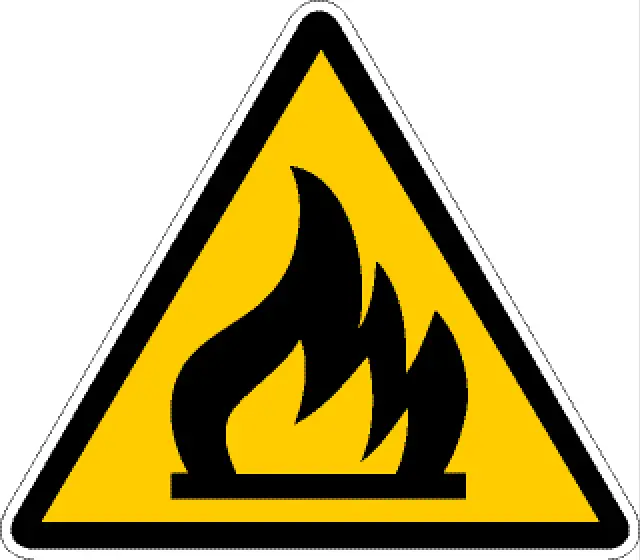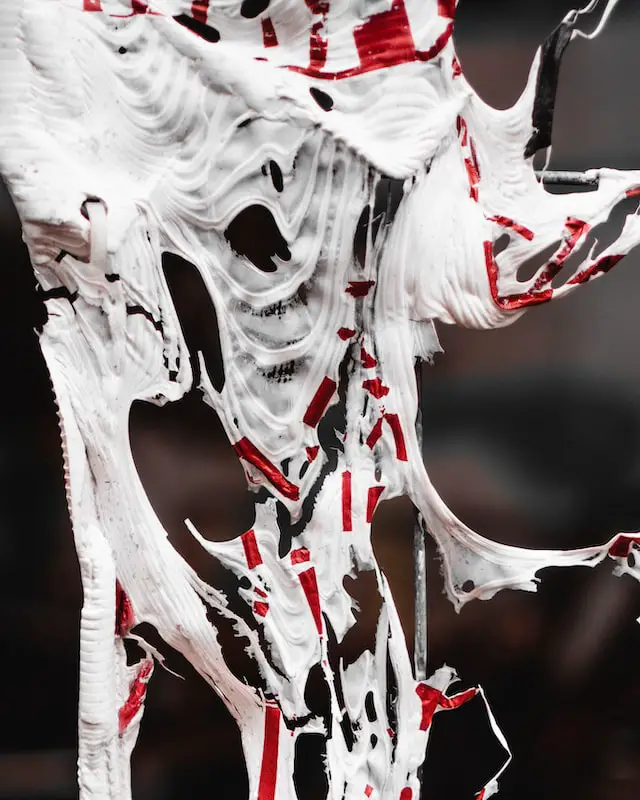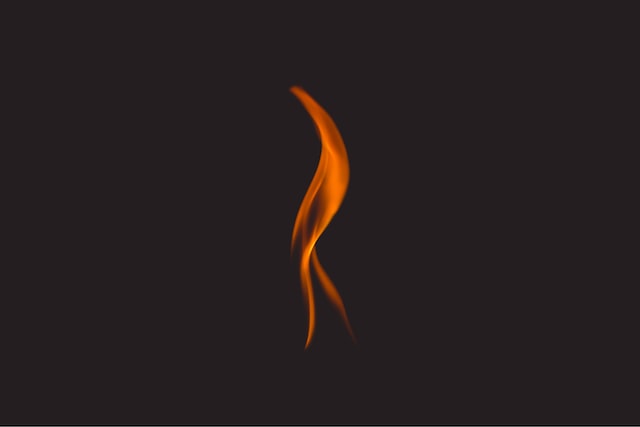Acrylic paint is a type of plastic emulsion used by artists. We know that almost all plastics can catch fire or become flammable. So you might wonder if acrylic paint is flammable.
Acrylic paint is not a flammable or combustible liquid when wet but a combustible plastic when dry. Acrylic paint should not be heated to higher temperatures due to toxic fumes and by-products. If burning acrylic paint for disposal, use an industrial furnace with emission controls.
Since acrylic paint is not an ignitable liquid, Safety Data Sheet for acrylic paint does not contain any information on flash point or self-ignition temperature. However, some of the acrylic paint colors when reacted with acid can become flammable. All of these will be discussed further in this article.
Is acrylic paint flammable?
Acrylic paint when wet is not flammable or combustible. Therefore manufacturers have not mentioned an ignition temperature or a flash point in the Safety Data Sheets. However, acrylic paint dries into plastic which is combustible and has an ignition temperature of 550 oF (290 oC).
The words flammable and combustible are tricky. Liquids are flammable when they ignite in temperatures lower than 100o F (37.8o C) or 199.4 °F (93 °C). Liquid acrylic paint is not flammable at all in these temperatures.
In simple terms, combustible material needs to be heated up to be ignited. A flammable material is easily ignitable even at working temperatures. So acrylic paint when wet is neither flammable nor combustible. But when it is dry, it becomes a plastic paint film that is combustible but still not flammable.
However, acrylic paint’s boiling point is >100oC/212oF, meaning you will see acrylic paint bubbling and boiling when the temperature is >100oC/212oF. I have seen this one time I used the heat gun to heat acrylic paint to extreme temperatures. However, you should not attempt heating acrylic paint at all.
When you burn acrylic paint which is essentially plastic, it creates monomer fumes. Monomer fumes are irritating to the respiratory system and repeated exposure may cause lung irritation and serious central nervous system disorders (source). Therefore you should never try burning acrylic paint or other plastics.
Acrylic paint or plastic should only be burned for disposal in a suitable industrial furnace with emission controls to remove the pollutants.
Ben Gavett at GoldenPaints.com
Can acrylic paint catch fire?
Dry acrylic paint can catch fire. It is known as an ordinary combustible material like cloth, wood, paper, and rubber. These ordinary combustible materials cause class A fires which can be extinguished by cooling the plastic below the ignition temperature.

The ignition temperature of acrylic paint would be 550 oF (290 oC). I got to know it from Ben Gavett at GoldenPaints.com according to a source he has found. So if you are taking out an acrylic paint fire you will need to cool down the plastic film below 550 oF (290 oC).
Acrylic paint when wet can hold more heat and is not a flammable or combustible liquid. When heated to higher temperatures you will see bubbling of acrylic paint but not burning. However, when acrylic paint has no water left in it, meaning when it is dry, it becomes plastic.
Technical information: Combustible and Flammable
To understand what is combustible and what is flammable, you will need to understand a bit of the technical side of the fire. I promise you this information is so fascinating and important to you, rather than being boring.
There are two industry standards to refer to if you want to learn about fire, combustibility, and flammability. they are Occupational Safety and Health Administration (OSHA), USA, and National Fire Protection Association (NFPA).
I have consolidated information from these two sources that are associated with acrylic paints below.
Combustible and flammable plastic
Acrylic paint is a combination of acrylic polymer binder, pigments, water, and other additives. When acrylic paint dries water leaves the paint film leaving acrylic polymer, pigments, and additives in place. This makes a film of acrylic polymer or plastic.
Acrylic paint when dry is a combustible plastic that falls under the category of ordinary combustible materials like cloth, wood, paper, and rubber. These materials cause class A type fires that can be extinguished by cooling the fuel below ignition temperature.
Now let’s see in detail how fires occur and where plastics as a fuel for fire fit in.
What makes something flammable?
Flammability is the ability of a material to catch on flame or fire. Fire is an oxidation process that happens very fast, so that light, heat, and sound are released (NFPA, reporters guide). When energy is liberated suddenly it increases temperature, sometimes up to a thousand degrees along with toxic fumes.
To make a fire 3 components are needed. This is known as the fire triangle. The components of the fire triangle are fuel, heat, and air. Fuel is what will burn in a fire. Heat makes fuel burn and there should be enough heat, air, or oxygen needed to start the fire reactions.
Fires are classified according to the type of fuel. There are class A, B, C, D, and K fires. The fires using ordinary combustible materials like cloth, wood, paper, rubber, and plastic as fuels fall into class A (NFPA, reporters guide).
Acrylic paint after drying which is a plastic film that is an ordinary combustible material that causes type A fires.
Fire extinguishing of class A fires is done by cooling the fuel below the ignition temperature. It can be done with either water or another suitable extinguishing agent. Suitable extinguishing agents recommended by Golden Paints in their Safety Data Sheets are carbon dioxide, foam, or dry chemicals. They have also mentioned using a self-contained breathing apparatus and full protective clothing when fire fighting.
Combustible and flammable liquid
Flammable and combustible liquids are classified as high fire hazards because water cannot be used to extinguish fires based on these liquids. Examples of these liquids are tars, oil-based paints, solvents, petroleum greases, alcohols, oils, and lacquers.
There are different classifications and definitions of combustible and flammable liquids according to NFPA and OSHA. Let’s learn about each of these classifications so that we can better understand where acrylic paint in a liquid state fits among flammable or combustible liquids.

Definition and classification according to the 2021 edition of NFPA 30
According to the 2021 edition of NFPA 30 classification, both combustible and flammable liquids are ignitable liquids. Ignitable liquids have a measurable flash point. However, a flammable liquid is a class I liquid while combustible liquids can be either class II or III liquids.
Flash point is the minimum temperature a liquid needs to create vapors that are sufficient to make an ignitable mix with air. There is an appropriate test procedure and apparatus to determine the flash point of a liquid. Now let’s see the different classes of ignitable liquids.
Class I liquid: A liquid with a flash point below 100o F (37.8o C) AKA a flammable liquid.
It is important to note that there is no flash point in the safety data sheets provided by the manufacturer for acrylic paints. Thus acrylic paint can be considered a nonflammable liquid and is not a class I, flammable liquid.
Class II liquids have flash points at or above 100o F (37.8o C) but below 140o F (60o C). These are also known as combustible liquids. Class III liquids have a flash point at or above 140o F (60o C). These are also combustible liquids.
Definition and classification according to OSHA 1910.106
According to OSHA 1910.106, a flammable liquid has a flash point at or below 199.4 °F (93 °C). As you may have noticed, the flash point is higher for flammable liquids according to OSHA, meaning the flammable liquids do not necessarily have to be at working temperature.
According to OSHA liquids are classified as flammable even if heated up to 199.4 °F (93 °C). The following table shows the different categories of flammable liquids according to OSHA 1910.106.
| Categories | Flash point | Boiling point |
| Category 1 | Below 73.4 °F (23 °C) | At or below 95 °F (35 °C) |
| Category 2 | Below 73.4 °F (23 °C) | Above 95 °F (35 °C) |
| Category 3 | At or above 73.4 °F (23 °C) and at or below 140 °F (60 °C) | |
| Category 4 | Above 140 °F (60 °C) and at or below 199.4 °F (93 °C) |
As wet acrylic paint can hold more heat, is non-self-igniting, and manufacturers haven’t mentioned a flash point in the health and safety data, it can be considered a noncombustible liquid according to either OSHA or NFPA guidelines.
Fires from Flammable and combustible liquids and gasses are classified as class B fires. They can be extinguished by creating a barrier between the fuel and the oxygen, such as creating a layer of foam.
Combustible and flammable solids
There is a category of combustible/ flammable solids when it comes to fire. However plastics or acrylic do not fall into this category. To understand how plastics differ from combustible/ flammable solids, let’s look at their definitions.
According to OSHA, a flammable solid is a readily combustible solid, or which can be ignited through friction. Readily combustible solids come as powdered, granular, or pasty chemicals. Some examples are powders of metals or metal alloys such as titanium, sodium, magnesium, zirconium, potassium, and lithium.
Fires from these combustible metals fall into class D fires. To extinguish class D fires, special powders based on sodium chloride, other salts, and clean dry sand will be used.
Acrylic paint is not a flammable solid that can be readily ignited like metal. Therefore acrylic paint remains as non-flammable and noncombustible even when dried into plastic.
What happens if acrylic paint Burns?
When acrylic paint is burning, it produces monomer fumes that are irritating to the respiratory system and repeated exposure may cause lung irritation and serious central nervous system disorders. Therefore you should never try burning acrylic paint.
According to the Safety Data Sheets of Golden Acrylic Paints, some of the colors like Paynes Gray, Ultramarine Violet, and Ultramarine Blue can produce hazardous decomposition or by-products when reacted with acids or strong oxidizers. These pigments can react with acids to form flammable and toxic hydrogen sulfide.
When acids react with cadmium pigments like cadmium yellow, cadmium red, and cadmium orange, it may produce toxic cadmium salts in the solution, flammable and toxic hydrogen sulfides, and selenide gases. If cadmium is heated above 800oC, toxic fumes of cadmium oxide, sulfur dioxide, zinc oxide, and selenium dioxide will form (source).

Is acrylic paint heat resistant?
High heat reduces the stability of the acrylic paint film. It can burn or cause bubbles in the acrylic paint film. The ideal temperature for acrylic paint when drying is between 70 to 90oF. Acrylic paint can hold a heat of a hair dryer or heat lamp. They can be used to speed up the drying process.
If you are interested to know more about acrylic paint drying and curing you can read the following article: How long for acrylic paint to cure? (Comprehensive answer). You will learn about many other factors that affect acrylic paint drying and how to take them to your advantage.
Blow torching acrylic paint
Blow torching wet acrylic paint to remove air bubbles is a common practice among artists doing acrylic pours. It is the most convenient and effective way of popping out air bubbles that can cause dents in the final painting if left out.
So I asked Blick Art Materials if there is a safety risk of blow torching acrylic paint. Here is what they have to say;
Blow torching air bubbles is the common way artists deal with that, and because it is only momentary, it does not pose a general problem of fumes or toxicity.
Nate from Product Information, Blick Art Materials
I also asked Golden Paints what effects heating acrylic paints has and here is what they have said.
Drying acrylic paint can take some heat, more on the scale of a hand-held hair dryer than a blow torch. If too much heat is applied, one will begin to see the paint bubble.
Ben Gavett at GoldenPaints.com
If you are interested in disposing of acrylic paint in an eco-friendly way you can read the article; Alternative for Acrylic Paint: Best Eco-Friendly Solution. You will also learn about the effect acrylic paint cause on the environment.
The bottom line
Acrylic paint is not classified as a flammable or combustible liquid. Flammable and combustible liquids have a warning sign on the bottle label, warning the consumer. Some examples of flammable paints are alcohol inks, oil paints, and lacquers. However, you should not heat acrylic paint more than a hair drier or a heat lamp. Higher temperatures will affect proper film formation and may also produce toxic fumes.

